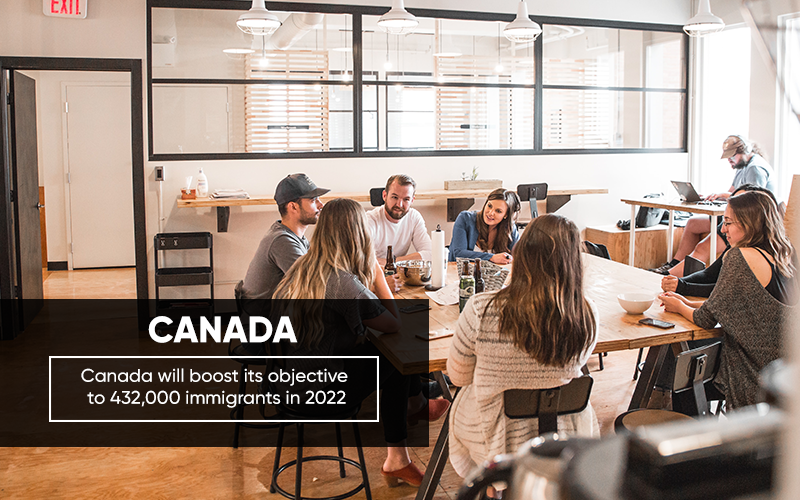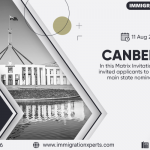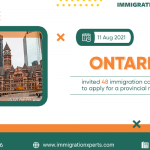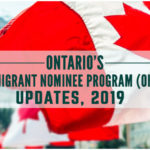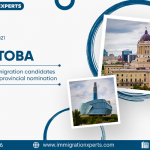Under the Immigration Levels Plan 2022-2024, Canada will boost its objective to 432,000 immigrants in 2022.
Canada has raised the goal even further, aiming to welcome 451,000 new immigrants by 2024. Immigration Minister Sean Fraser described the basis for the new levels plan in a statement to CIC News.
The Canadian government just released its Immigration Levels Plan for the years 2022-2024.
Canada's immigration objectives have been raised again. It will aim to welcome about 432,000 new immigrants this year, rather than the 411,000 it had planned.
At around 3:35 p.m. Eastern Standard Time, the news was announced.
Canada will aim for the following number of new immigrant arrivals over the next three years:
431,645 permanent residents in 2022 447,055 permanent residents in 2023 451,000 permanent residents in 2024
"This levels plan is a balancing of requirements for our country and our international duties," Immigration Minister Sean Fraser said in a statement to CIC News. It emphasizes recruiting qualified people who will contribute to Canada's economy and address the labor deficit, as well as acknowledging the value of family reunions and assisting the world's most vulnerable communities through refugee resettlement. Our priority remains on boosting our economic recovery by increasing immigrant retention in areas where significant economic, labor and demographic issues exist. I'm pleased with what Canada has accomplished so far, and I'm excited to see how newcomers will continue to make Canada a desirable place."
Approximately 56% of new immigrants will enter in 2022 through economic class channels such as Express Entry, the Provincial Nominee Program, and the Temporary to Permanent Residence (TR2PR) stream, which was accessible in 2021.
Immigration, Refugees and Citizenship Canada (IRCC) expects 83,500 arrivals under the Provincial Nominee Program (PNP) in 2022. IRCC has decreased Express Entry admissions in half for this year, but it hopes to recover to normal levels by 2024 when it expects 111,5000 Express Entry immigrants to arrive.
The levels plan appears to indicate that IRCC is temporarily decreasing Express Entry admissions to make room for TR2PR admissions. Under the TR2PR stream, IRCC hopes to land 40,000 immigrants in 2022 and the last 32,000 immigrants in 2023.
Meanwhile, Express Entry draws are held every two weeks, and IRCC continues to handle Express Entry applications.
Furthermore, the PNP is used by the majority of Canada's provinces and territories, and PNP invites have been continuing since the outbreak began.
In 2022, the family class will account for 24% of admissions objectives, with 80,000 people expected to enroll in the Spouses, Partners, and Children Program and 25,000 in the Parents and Grandparents Program (PGP). In comparison to its earlier strategy, the IRCC has boosted its PGP admissions objective by 1,500 slots.
The remaining 20% of immigrants will be admitted through refugee and humanitarian programs. This is a 5 percentage point increase above Canada's previous immigration levels plan, and it is most likely due to Canada's plans to relocate 40,000 Afghan refugees over the next several years. Because of the larger refugee and humanitarian intake, economic and family class immigration will account for a smaller percentage of entrants than typical in 2023 and 2024, as Canada intends to reduce its refugee and humanitarian intake once its Afghan resettlement program is completed.
| Immigration Class | 2022 | 2023 | 2024 |
|---|---|---|---|
| Economic | 241,850 | 253,00 | 267,750 |
| Family | 105,000 | 109,500 | 113,000 |
| Refugee | 76,545 | 74,055 | 62,500 |
| Humanitarian | 8,250 | 10,500 | 7,750 |
| Total | 431,645 | 447,055 | 451,000 |
The first Immigration Levels Plan since October 2020 was announced today.
The Immigration and Refugee Protection Act (IRPA), Canada's principal immigration statute, mandates that the Canadian government must declare its immigration strategy by November 1 of each year, while Parliament is in session. Last year, however, a level plan announcement was postponed owing to the Canadian government's September election.
The immigration system in Canada is guided by the levels plan. It lays forth the number of immigrants that Canada plans to accept through its various federal, provincial, and territorial schemes. The provinces and territories, as well as Immigration, Refugees, and Citizenship Canada (IRCC), alter their operations in accordance with the plan to ensure that they are able to attract, settle, integrate, and retain the intended numbers of newcomers.
Until 2015, Canada received around 250,000 immigrants per year. It set a new baseline goal of 300,000 arrivals each year in 2016. Prior to the pandemic, the objective was set at around 340,000 immigrants per year, however owing to the pandemic, immigration plummeted below 200,000 in 2020.
The Canadian government then surprised the world by announcing in October 2020 that it would seek to accept over 400,000 immigrants yearly in the future to aid the country's post-COVID economic recovery. This is the most ambitious goal in Canadian history.
Last year, Canada set a new record for newcomers by welcoming 405,000 permanent residents, the majority of whom were already living in the nation. Prior to the pandemic, the majority of new immigrants to Canada came from other countries.
Express Entry, the Provincial Nominee Program (PNP), and Quebec's streams accounted for 62% of new immigrants in 2021.
Last year, the Spouses, Partners, and Children Program and the Parents and Grandparents Program each welcomed 20% of the family class.
In 2021, a total of 15% were accepted into refugee and humanitarian programs.
"All Other Immigration" was used to classify the remainder.
Canada seeks a large number of newcomers to help the country's economy and finances. Canada requires more immigration to sustain its population, labor force, and economic growth, as well as to have enough employees to pay the taxes required to support critical social services like health care and education. Reuniting families, giving humanitarian aid, and preserving Canada's Francophone heritage are among the social immigration goals pursued by the country.
During the pandemic, immigration has undoubtedly become more economically important. Due to higher expenditure and reduced economic activity as a result of the epidemic, governments throughout Canada are running budgetary deficits. Furthermore, due to Canada's aging population, huge economic changes under COVID, and fewer immigrants migrating from outside, firms across the country are experiencing labor shortages.
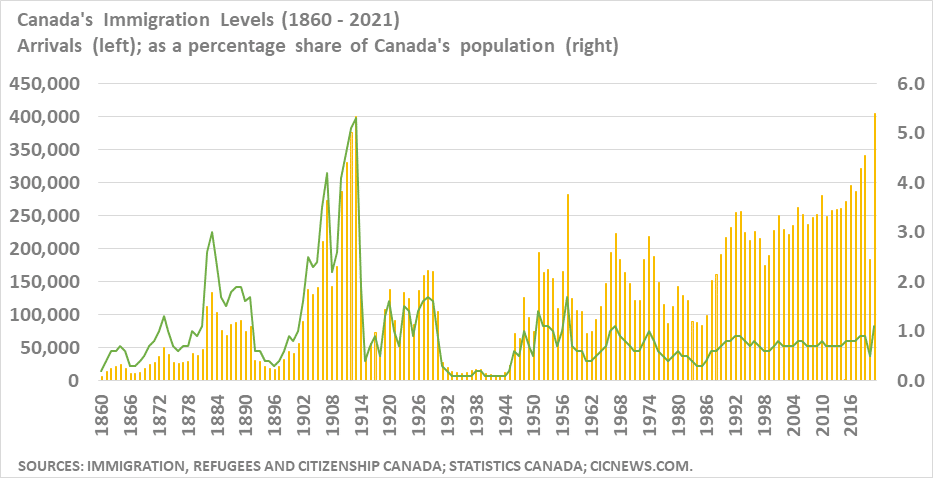
By November 1st, 2022, the Immigration Levels Plan 2023-2025 will be released.
Unless Canada has an election for the second year in a row, the Canadian government will be legally compelled to submit its second Immigration Levels Plan of the year no later than Tuesday, November 1st, 2022. This proposal will take the place of the one that was revealed today.
The announcement for 2021 was postponed owing to the federal election in September, as previously stated.
The Immigration Levels Plan 2023-2025 will be the normally scheduled announcement.
At Immigration Experts, we guide your clients with the best possibilities of moving to Canada (https://www.immigrationxperts.com/canada-immigration/67-canada-immigration-point-system/) with regards to their professional background.
To Stay Updated on Canada Immigration News, Subscribe to Immigration Experts
NEWSLETTER: https://www.immigrationxperts.com/newsletter/
Fill up our Free Evaluation Form and take the initial step towards your Visa and Immigration Process.We are available for ONLINE CONSULTATION!
Contact Immigration Experts for FREE Points-Based Assessment of your profile: Drop us an email at: info@immigrationxperts.com
Give us a call at: +91-9999467686, 0120-6618011, 0120-6618123
Book your appointment with our experienced immigration counselors and solve all your immigration-related queries at the comfort of your home.
We are available on Skype: Immigrationxperts.com
Achieve your Immigration dreams with Immigration Experts

